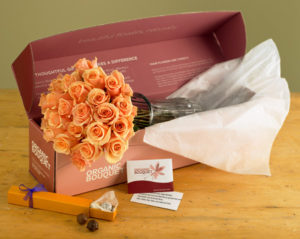Why organic flowers?

But when flowers are doused in pesticides and transported long (i.e., energy-intensive) distances, their eco-appeal quickly evaporates. The health impact conventionally-grown flowers has makes them even less desirable.
Consider this: Seventy percent of U.S. flowers are imported from Latin America, where growers in Columbia, Ecuador and other countries use pesticides that have long been banned in the U.S. A 2002 survey of 8,000 Colombian flower workers revealed exposure to 25 carcinogenic or highly toxic pesticides that are not used in the United States.
Often, women flower growers suffer impaired vision, asthma, and miscarriage or give birth to babies marked by lower birth weights and higher blood pressure. Thirty-five out of 72 Ecuadoran children tested by the Harvard School of Public Health experienced organophosphate pesticides in the womb while their mothers grew flowers. These children later suffered both higher blood pressure and poorer spatial ability than kids who escaped prenatal exposures.
Overall, according to a study by the International Labor Rights Fund (ILRF), two-thirds of Colombian and Ecuadorian flower workers suffer work-related health problems ranging from impaired vision and neurological problems Some women give birth to stillborn infants, or see their children die within a month after birth.
Meanwhile, the International Labor Organization estimates that 20 percent of flower workers in Ecuador are children, who are more vulnerable to chemical hazards than adults because their immune systems and vital organs are still immature.
According to Environmental News Network, roses can contain as much as 50 times the amount of pesticides that are legally allowed on the food we eat. The U.S. requires imported flowers to be bug-free, but unlike edible fruits and vegetables they are not tested for chemical residues. So even if you’re not growing these flowers yourselves, you may still be bringing the chemicals used on them into your home.
Fortunately, shoppers have a whole bouquet of alternatives to conventionally grown flowers and plants.
• Buy local – Check www.localharvest.org to find flower growers in your area, who can use less pesticides and less energy to get flowers to your door. Farmers markets also sell potted flowers and house plants that can make wonderful botanical gifts.
• Buy certified organic flowers. Some options to look for:
Veriflora – Veriflora requires organic farming practices, ecosystem protection, 

California Organic Flowers grows organic flowers in season, including Anemones, Protea, Narcissus and Dutch Iris.
The Sun Valley Group offers organic lillies, tulips, hyacinths and freesias, available wholesale as well as from a limited number of local retailers.
Storefronts: Whole Foods, food coops, natural food stores and other responsible retailers are increasingly carrying organic flowers and plants. If you don’t see them when you shop, ask for them.









